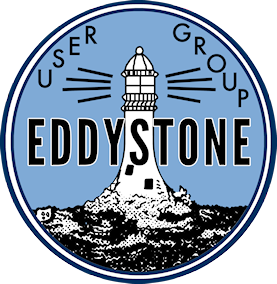Contact & Comments
You can contact the Eddystone User Group by writing to
Chris Pettitt
EUG Webmaster
12 Hennals Avenue, Webheath, Redditch, B97 5RX
Or by email g0eyo(at)blueyonder.co.uk
REGRETFULLY DUE TO MALICIOUS HACKING WE HAVE HAD TO DISABLE TO COMMENTS FACILITY ON THIS PAGE SO TO CONTACT US USE THE EMAIL ADDRESS ABOVE.
By far the best way of entering into a dialogue with other Eddystone enthusiasts is to join the Eddystone User Groups.io forum. https://groups.io/g/EddystoneUserGroup Here you will find 400+ Eddystone enthusiasts and experts who can answer your questions and give advice.

I have a 750 receiver which I have no use for. I think it no longer works but is in fair condition for its age. If anyone is prepared to collect from IP25 I am happy to give it away.
1Hi I’ve found a radio dial cover wich bears a lighthouse, I’m lead to believe it is from an eddystone radio but I can’t find one can someone please contact me and I can send photos cheers.
2I have now obtained an 830/9 serial number Br1287 for your records.
please remove from wanted list.
3The addition of a PD to a 680 has prompted me to ask if anyone has done the same to a 750… I have a spare 750 awaiting restoration and details of others efforts would be welcome.
4Pete VK3IZ jupete@internode.on.net
I have recently been looking through scans of pre-war and wartime copies of Wireless World and am puzzled by a number of references to Eddystone trimming condensers. These appear to be the concentric tube type, with a twin-start thread locating the rotor; turning the rotor causes it to plunge in and out of the stator and vary the capacitance. Both rotor and stator appear to be formed from billets of aluminium and the design is very distinctive with a triangular protrusion forming the ‘nut’ which engages the threaded centre pin.
I have always known these as ‘Philips’ trimmers and had no idea of any connection with Eddystone (except that they were used in some Eddystone receivers). Most post-war literature calls them “Philips trimmers”.
Were they an original Eddystone product, or were they made by Philips and imported and re-badged by Eddystone in the 1930s?
5Eddystone made lots of components right from the early days of radio (1920s) and you will find component catalogs on this website. All were made and designed at the Eddystone factory. Chris G0EYO EUG Webmaster
6Hi Chris,
7Great web site and merry bunch of followers.
My interest in Eddystone Radios has been reignited having acquired an 840A. New HT smoothing capacitors and a UL41 cured the hum. Now for the big challenge, purchased an EC958/1 that has been in the wars. Thanks to Ian for his help so far with the supply of parts, progress is being made. Unfortunately only just discovered that the massive impact and bent metal work have caused damage to the BFO (LP3054) and 100Khz Filter (LP3047A). L32 in the BFO has been ripped away from its base with only one wire still connected. Only three wires are visible, the fourth is not detectable. As for the 100Khz filter, one of the wafer switch contacts have been destroyed. So a big wanted request for either of these pars please.
Phil
8Have you signed up for the Eddystone User Group group.io forum. Great place for getting help and advice.
Chris G0EYO